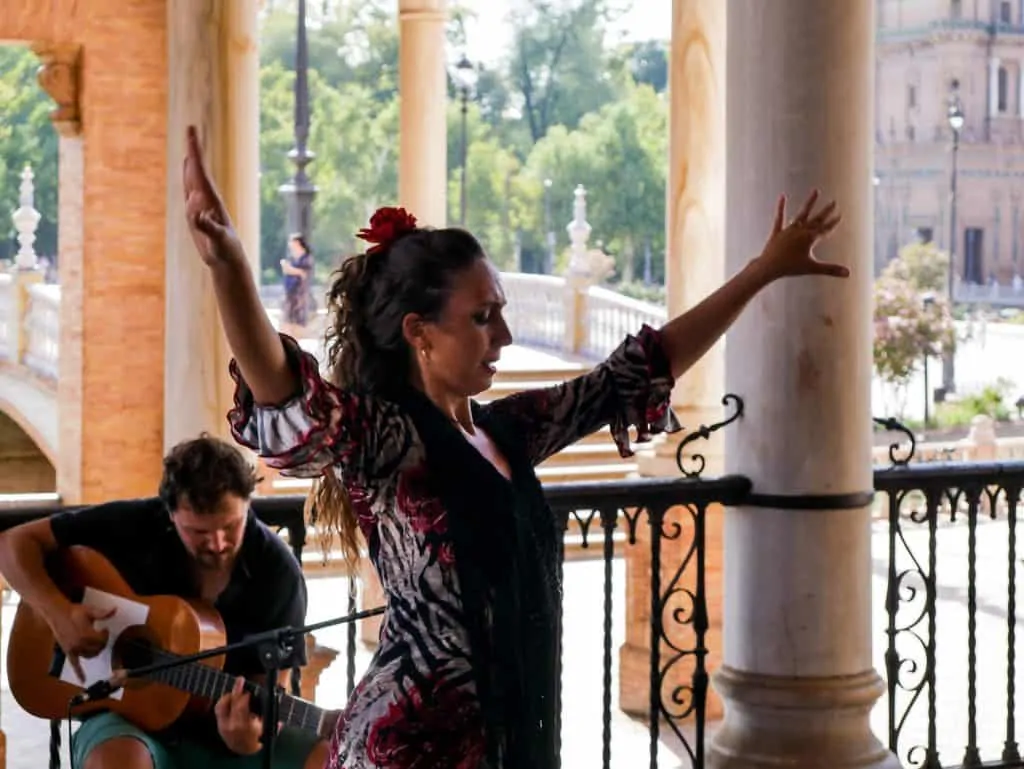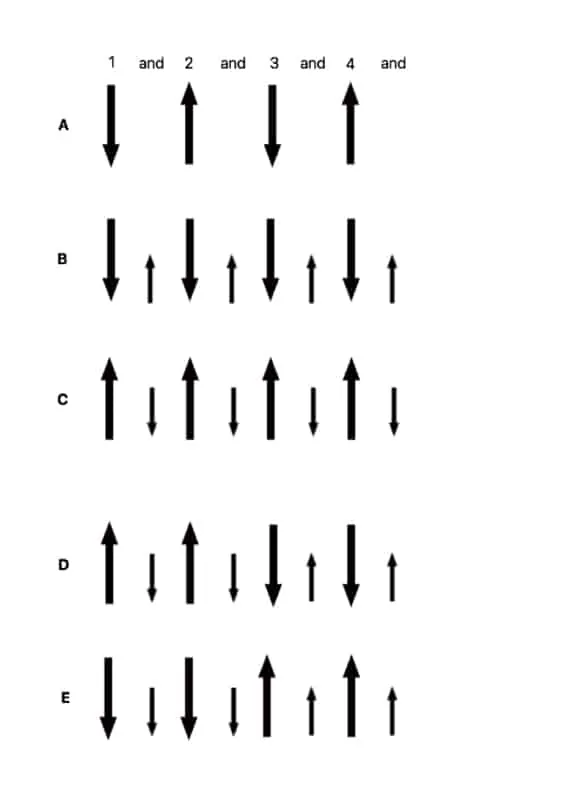Spanish guitar, or more commonly known as ‘flamenco’ guitar, is a unique style of playing using a nylon-strung guitar, which is usually a specialized flamenco instrument. The flamenco style of playing utilizes percussive strumming and fingerpicking technique, with an emphasis in fingerstyle plucking and ‘raking’. It is often high energy playing, accompanied traditionally by a percussionist on a cajon, singers, and often dancers.
What can sometimes get confusing is, the term ‘spanish guitar’ usually refers to both flamenco and classical guitars, which are actually very different instruments used for different purposes.
Contents
Spanish vs Classical guitars
What makes a flamenco guitar different from a classical nylon-strung guitar? The main differences are in their construction and sound, the first and most important differentiator bieng volume. Traditionally, the guitar in flamenco music was used as an accompaniment to loud singing and dynamic dancing, and proved to be too soft. Luthiers did their best to solve the problem by creating a guitar that was:
- Lightly built; in order to respond quickly
- Had strong high and middle frequencies
- Had a low, fast action
- Had a lighter, thinner soundboard and body
The flamenco guitar was born.
A concert classical guitar is constructed from thicker wood, is built mainly with cedar or spruce tops, has a slightly wider neck, and a deeper body. There is a fair amount of overlap in classical techniques and flamenco, however each guitar serves to accentuate its inherent style.
A traditional flamenco guitar has much thinner wood making up the top, back, and sides, the body is constructed solely from cedar, and is thinner than a classical. The strings are closer to the fretboard resulting in a lower action, enabling faster playing. They are also usually fitted with a tap-plate; a protective plate made from plastic which enables the player to tap the guitar without chipping away the wood. A flamenco guitar’s sound is far more responsive, percussive, and brighter than a classical, in order to make middle and higher frequencies stand out.
One final difference is sustain. A classical guitar produces notes that sustain more after being plucked, whereas a flamenco guitar benefits from shorter notes, ensuring that the speed and intricacy of notes do not become too muddy.
This video gives a pretty thorough rundown of the main differences between the two:
So although on the surface the two appear similar, they are different in a few small but crucial ways. Differences aside, it is most definitely possible and acceptable to play spanish or flamenco music on a classical guitar and vice versa; as the key to the spanish sound really lies in the nylon strings.
If you are looking to dip your toe into some Spanish waters, here are a few simple tunes and techniques to get you going.
Malaguenas
Malaguenas is a popular beginner spanish guitar tune, learned by budding flamenco guitarists the world over. It is a great one to start with as there are three main parts to learn with varying complexity. It begins with a fairly simple bass groove on two strings, moves to a four chord strumming section, and ends with a moderately difficult and quick lead part. The great thing is all three of these parts can be played simultaneously with friends or a loop pedal.
Lets begin with the bass groove:
Flamenco guitar is traditionally played using only fingers, with long nails on the right hand acting as plectrums. This sequence should be practised using the thumb only. It is the bassline of the song, played only on the E and A strings.
A|——2-|—-2-|-0-3-2-|-0——-|
E|–0-4—|0-4—|——-|—3-1-0-|
This simple bass groove is repeated throughout the song, adding a nice background for the chords and lead to go over.
Chords:
This song uses the ‘raking’ strumming technique, which can be practised using the ‘up/down’ exercise. This technique should be applied to the rhythm section of all three songs outlined in this post.
In flamenco music, the fingers are used in a downward raking motion, using the right hand nails over the strings. Tradionally flamenco players will grow the nails of thier right hands which will act like plectrums.
Its a fairly simple technique, but can take a bit of practise to get the hang of. As you move your hand down to strum, begin by hitting the strings with first your ring finger, followed by the middle, then index, and finally with the thumb. On the up strum, you will do the opposite; begin with the thumb strumming up, and move through to the ring finger.
This will give you the classic spanish sound in your rhythm playing.
Begin by doing the exercises in 4/4, slowly at first.The big arrows indicate an up or down strum on the beat, while the small arrows are strummed between the beats, on the ‘and’ count.
Malaguenas consists of only four chords: E, Am, G, and F. In order to get a more ‘Spanish’ sound, we recommend playing the G and F as barre chords. This also makes playing the song more fluid, as you can easily slide the G chord shape down to the F.
G Barre Chord
E—–3–|
B—–3–|
G—–4–|
D—–5–|
A—–5–|
E—–3–|
Then, slide the same shape down to F:
E—–1–|
B—–1–|
G—–2–|
D—–3–|
A—–3–|
E—–1–|
The entire chord sequence is played as follows: E, Am, G, F. Try playing it with only down strums at first, and then add in the up strums in-between counts when you feel more confident.
Time count: 1 2 3 4 | 1 2 3 4 |
Chords: E E
Strumming: | | | | | | | | | | | | | | | | | | | | | | | | | | | | | | | |
1 2 3 4 | 1 2 3 4 |
Am G F
| | | | | | | | | | | | | | | | | | | | | | | | | | | | | | | |
Lead Sequence:
Here, it gets slightly more difficult. As always, play the part really slowly at first until you are completely familiar with it, and speed up gradually. The lead guitar part will take a fair amount of practice to perfect. Start by playing the sequence with a pletrum or you your thumb, and then move onto using your fingers: use your thumb for playing notes on the top 3 strings( E, A, and D), and your index on the G, middle on the B, and your ring finger on the E.
e|–0-1-3-1-0————————————————|
B|————–0-3-1-0-1———0-1-0-3p1p0———–|
G|—————————2-1-2——————2-0——|
D|————————————————————–|
A|—————————————————————|
E|—————————————————————|
e|———————————————————————–|
B|———————————————————————–|
G|–3-2——0———————————————————|
D|——-2-3—3-2—-0—————————0—————–|
A|———————2—3-2-3—-0—0-2-3-2—3-2-0———-|
E|———————————-4—————————3-1-0–|
Now, the traditional version of the song does get a bit more complex in the lead parts, but we’ll keep it simple for this lesson.
Guantanamera
Guantanamera is a classic standard for Spanish guitar. It is fairly easy to play, and unlike malaguenas has lyrics to sing along with! Have a listen to the song in the video above to get an idea of the melody and time signature.
Once you get familiar with the melody, give the song a try. Again, use simple down strums at first until you are familiar with the song. Here are the chords along with the lyrics to make it easy to follow along:
Chorus
G C D C G C
Guantanamera, guajira guantanamera
G C D C G C
Guantanamera, guajira guantanamera
Verse
G Am D C G Am
Yo soy un hombre sincero, de donde crece la palma
G Am D C G Am
Yo soy un hombre sincero, de donde crece la palma
G Am7 Bm7 Am7 G Am D
Y antes de morirme quiero echar mis versos de alma
There is one other part for the song. This section can be played both as an intro and in-between versus. This part is basically just arpeggiated chords, and is fairly simple fingerpicking. Use your thumb for the top 3 strings( E, A, and D), and your index on the G, middle on the B, and your ring finger on the E.
e|—————–0——-2——-0—–0———————————|
B|—————2——-3——-0—0—–0——————————-|
G|————-2——-2——-1——-0———————————–|
D|——————-0—————————————————–|
A|———–0————————————————————-|
E|–0–2–4——————0———————————————|
La Bamba
La Bamba is a traditional Mexican folk song, made popular by the band Los Lobos who topped the charts with it in 1987.
The great thing about this song is that it’s the same as Malaguenas in that there are three parts to learn which go together in one piece, or are great played on their own. Lets begin with the bassline. Again use only your thumb, or both your thumb and index finger to play the bassline.
Bassline
e|———————————————————————————–|
B|————————————————————————————|
G|—————————0—3–2–0——————————–0———|
D|———–0———-2——————3–2—0———0——2————-|
A|——–2———-3————————————2——-3—————-|
E|—–3———————————————–3—————————-|
Chords
There are only three chords used in the entire song for La Bamba. G, C, and D. The song is in a 4/4 time signature, and is played using the raking technique outlined above. Begin by playing only with down strums to get the feel, and as you get the hang of it add in some up strumming too. You will be playing three strums(up, down, or both) for each chord, accept on the D on which you will play six. The lines below the chords indicate the strums.
Time Count: 1 2 3 4 | 1 2 3 4
Chords: G C D G C D
Strumming | | | | | | | | | | | | | | | | | | | | | | | |
Lead section
The lead section can be a bit of a challenge to play at the tempo needed, so, as always, take it slow at first. Use your thumb or even a plectrum at first until you feel familiar with the piece. Once you have memorised it and are acustomed, follow standard finger style methods and use your thumb on the D string, index on G, middle on B, and ring ringer on E.
e|————-0————————————————————————-|
B|—–3-3-0—1-3—3-3-3-1-0—————————————-0-1——–|
G|———————————–2—0-0-0-2-2—————–0-2————–|
D|—————————————————–0——-0-2-4——————–|
A|—————————————————————————————-|
E|—————————————————————————————-|
Final Thoughts
These three tunes will get you well on your way to playing Spanish and flamenco guitar styles. It will help greatly to learn a few classical guitar and finger style techniques along side these songs; they will go a long way in helping you learn the Spanish style.They are simple to learn, you can teach the parts to friends and jam along together, and even sing along if you feel so inclined!
Here’s one more video from the master player Estas Tonne to get you inspired to play flamenco guitar:




